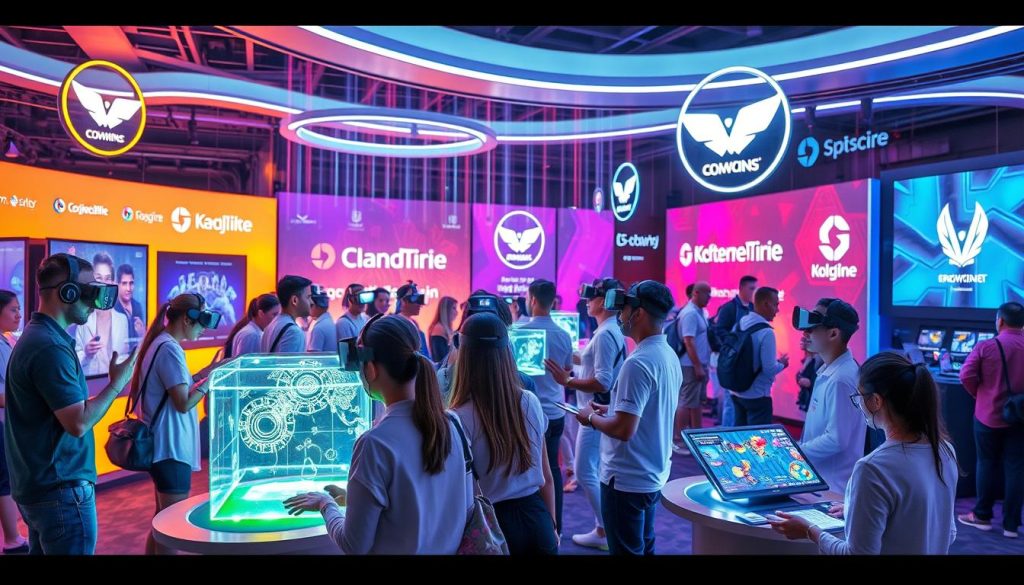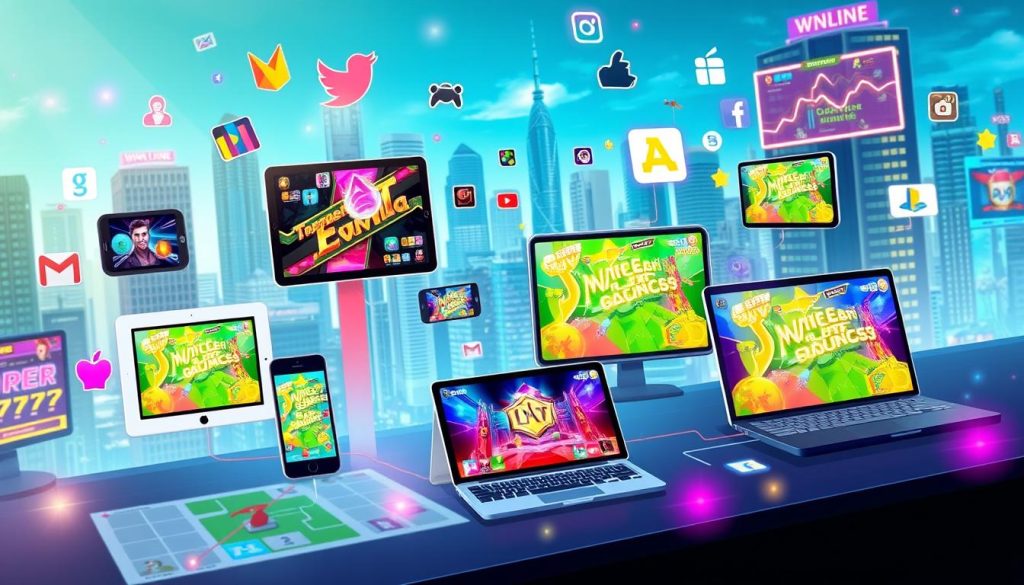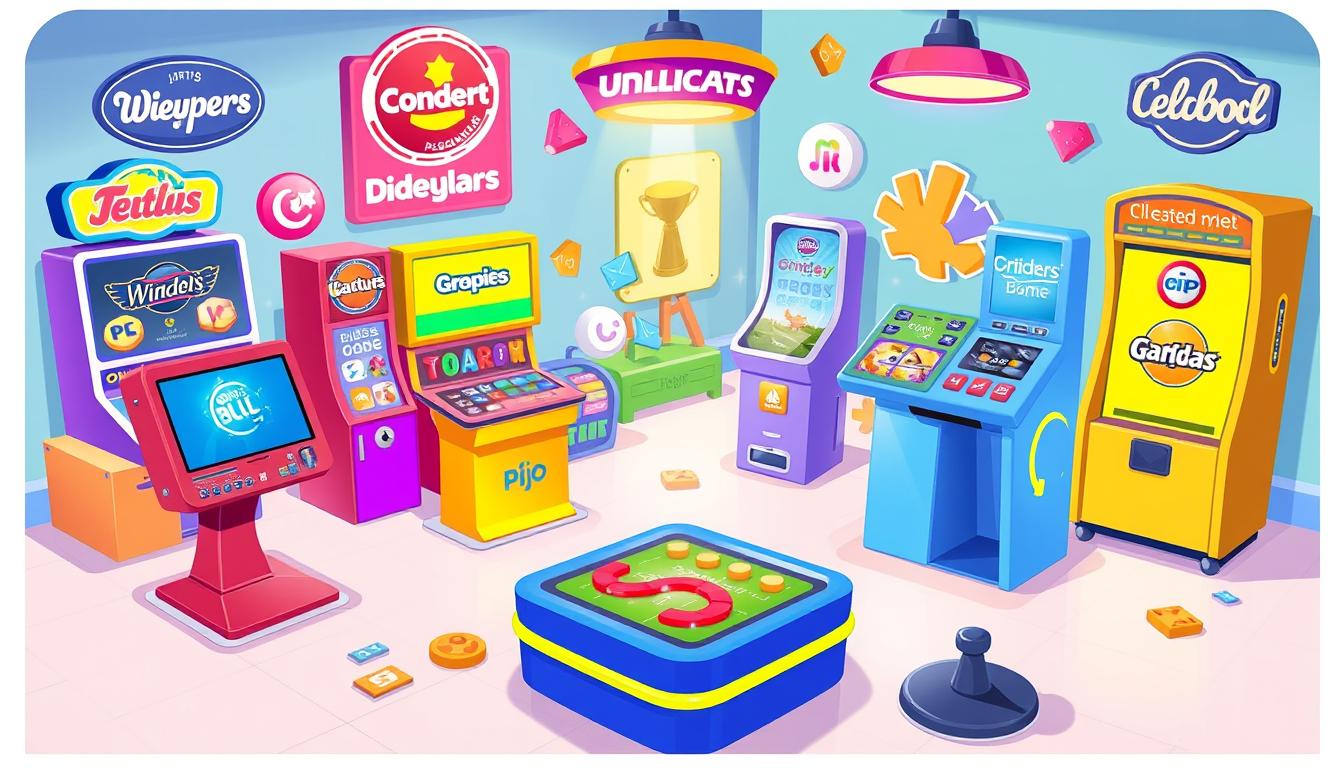In today’s digital world, smart businesses use branded games to grab their audience’s attention. They blend games into their marketing plans to connect with people, grow loyalty, and boost sales. The power of branded games in lead capture is changing how companies get and keep customers.
Key Takeaways
- Branded games can significantly boost lead generation and customer engagement.
- Gamification marketing strategies effectively capture high-quality leads and build brand loyalty.
- Designing effective branded games requires aligning game mechanics with brand values and objectives.
- Measuring the success of branded games through key performance indicators (KPIs) is crucial.
- Integrating branded games into omnichannel marketing strategies amplifies their impact.
Introduction to Branded Games and Lead Capture
Marketing is changing fast, moving towards Interactive Marketing. Brands now see the value in engaging their audience with fun, interactive experiences. This has led to the growth of Branded Games.
Understanding the Shift Towards Interactive Marketing
Old marketing ways, like one-way messages, are fading. Today, people want to interact and remember brands. Branded Games are a key way for brands to connect with their audience.
The Role of Gamification in Engaging Audiences
Gamification is at the core of this change. It adds game elements to marketing, making it fun and engaging. This approach boosts Audience Engagement and Lead Capture.
This part explores how Branded Games help capture quality leads. By grasping interactive marketing and Gamification, marketers can use Branded Games to engage and get valuable leads.
The Power of Branded Games in Capturing High-Quality Leads
In the fast-paced world of digital marketing, smart businesses use branded games to get valuable leads. These games engage people, making it easier for brands to attract and keep potential customers. This approach helps grow businesses by turning leads into loyal customers.
Understanding the move to interactive marketing is key. Today, people want more than just ads. They want experiences that feel real and personal. Branded games offer a way for brands to connect deeply with their audience.
By adding gamification like challenges and rewards, brands can grab attention. This not only makes the brand more memorable but also brings in high-quality leads. These leads can become loyal customers over time.
“Branded games are the ultimate lead-capturing tool, allowing businesses to engage their audience, collect valuable data, and nurture prospective customers into long-term brand advocates.”
Using branded games opens up new ways to get leads. It’s not just about getting data; it’s about building real connections. This approach can change the game for any company looking to grow and expand its customer base.
Benefits of Branded Games for Lead Generation
Branded games are a powerful tool for lead generation. They offer benefits that go beyond traditional marketing. Games engage and interact with people, turning them into valuable leads.
Increased Brand Awareness and Recall
Branded games boost brand awareness and recall. They integrate the brand’s identity and values into the game. This makes players more familiar with the brand, improving recognition and recall.
Improved Customer Engagement and Retention
Branded games create a strong bond with the brand. When customers play games that match the brand, they feel closer to it. This loyalty leads to better retention, as they’re more likely to stay engaged with the brand.
| Benefit | Description |
|---|---|
| Brand Awareness | Branded games enhance brand visibility and recognition by immersing players in the brand’s identity and values. |
| Customer Engagement | Interactive branded games foster a stronger connection between customers and the brand, leading to increased loyalty and retention. |
| Lead Generation | Engaging branded games can effectively capture user information and generate high-quality leads for the brand. |
Branded games open up new ways for businesses to generate leads and engage customers. They offer a unique and memorable experience to their audience.
Designing Effective Branded Games
Making great branded games needs a smart plan. It’s about matching the game’s fun parts with the brand’s values. This mix makes the game fun and true to the brand, building a strong bond with its fans.
Aligning Game Mechanics with Brand Values
When making branded games, think about how the game’s mechanics show off the brand’s identity. This connection turns a game into a strong marketing tool. It boosts brand awareness and connects with the audience.
- Find out the brand’s main values, like being innovative or caring about the planet.
- Add game parts that show these brand values clearly, making the game feel real.
- Make sure the game’s goals, challenges, and rewards match the brand’s mission and message.
- Use game mechanics that let players interact with the brand in meaningful ways, like sharing or doing tasks.
By matching the game design with the brand’s values, companies can make branded games that grab people’s attention. These games help build strong connections and bring in valuable leads.
| Brand Value | Corresponding Game Mechanics |
|---|---|
| Sustainability | Recycling challenges, eco-friendly choices, energy conservation |
| Innovation | Futuristic technology, problem-solving puzzles, creative customization |
| Customer-centricity | Personalized rewards, user feedback integration, customer support features |
“Successful branded games blend the brand’s identity with fun gameplay. This makes a powerful marketing tool that speaks to the audience.”
Gamification Marketing: Best Practices
In Gamification Marketing, the right Incentives and Rewards can change the game. They boost user engagement and lead generation. By using these elements wisely, businesses can make games that grab their audience’s attention and get results.
Leveraging Incentives and Rewards
To make a great gamification plan, you need to know what drives your audience. A well-thought-out system of incentives and rewards can unlock more user participation and better conversion rates.
- Give meaningful rewards that match your brand’s values and appeal to your audience.
- Use a mix of immediate and long-term rewards to keep users engaged.
- Use leaderboards, badges, and achievements to create a competitive and rewarding atmosphere.
- Keep checking and tweaking your incentive and reward setup based on user feedback and data.
By matching your gamification with what your audience likes and needs, you can make branded games. These games will not only grab their interest but also turn them into valuable leads for your business.
“The secret to effective gamification lies in understanding what drives your audience and tailoring your incentives and rewards accordingly.”
Interactive Brand Experiences: Case Studies
In digital marketing, interactive brand experiences are key for getting great leads. Branded games make it fun for people to learn about a brand. Let’s look at some examples that show how well this works.
A big name in consumer electronics ran a cool campaign. They made a game where players explored a virtual showroom. This game brought lots of people to their site and gave them useful data. This data helped the brand tailor its marketing and keep in touch with leads.
In the car world, a famous brand used interactive brand experiences to get noticed. They made a game where people could try out cars online. This game got people excited and gave the brand insights into what customers want.
| Brand | Interactive Experience | Key Outcomes |
|---|---|---|
| Consumer Electronics Brand | Virtual Product Showroom Game | Increased website traffic, generated high-quality leads |
| Automotive Manufacturer | Virtual Test-Drive Simulation | Increased brand awareness, generated valuable customer insights |
These examples show how interactive brand experiences grab people’s attention and get leads. By using gamification, brands can make fun, memorable experiences. These experiences connect with people, helping the brand grow.

“Interactive brand experiences are the future of digital marketing. By tapping into the innate human desire to play and explore, brands can create lasting connections with their customers.”
Measuring the Success of Branded Games
Businesses use Branded Games to get high-quality leads. It’s key to measure how well these games work. By looking at Key Performance Indicators (KPIs), companies can learn a lot. This helps them make better choices for their Branded Games.
Tracking Key Performance Indicators (KPIs)
There are important Key Performance Indicators (KPIs) to watch when checking Branded Games success:
- User Engagement: Look at session duration, pages per session, and bounce rate. These show if the Branded Game is keeping people interested.
- Lead Generation: Keep an eye on how many leads the Branded Game gets. Also, check the quality and how many of these leads turn into customers.
- Brand Awareness: See how the Branded Game affects people knowing your brand. Watch social media, website visits, and search engine rankings.
- Return on Investment (ROI): Figure out the money side of the Branded Game. Look at how much it costs to get customers, sales, and revenue.
By watching these Key Performance Indicators (KPIs), businesses can really understand their Branded Games. This helps them improve their marketing plans.
It’s vital to measure Branded Games success. This ensures they’re helping the business grow. By using the right Key Performance Indicators (KPIs), companies can make their Branded Games better. This leads to more growth over time.
Integrating Branded Games into Omnichannel Strategies
Businesses aim to give top-notch customer experiences. They use branded games in their marketing plans. This makes the experience fun and engaging, helping to get more lead capture everywhere.
It’s important to match the games with the overall marketing plan. This means putting the games in places like websites, social media, and stores. It helps build a strong brand image and keeps customers interested.

Using branded games helps get important customer data. The games let businesses know what customers like and how they act. This info helps improve marketing and make the customer experience better.
Games also make customers more engaged and loyal. They create fun experiences that customers remember. This makes customers more likely to come back and stay loyal to the brand.
“Integrating branded games into omnichannel strategies is a strategic move that can elevate the customer experience and drive powerful lead capture results.”
In today’s digital world, using branded games in marketing plans is key. It helps businesses stand out and offer great value to their customers.
Emerging Trends in Branded Gaming
The world of branded gaming is changing fast. New technologies like Augmented Reality (AR) and Virtual Reality (VR) are making a big impact. These trends are changing how brands connect with people, offering exciting experiences that grab attention and inspire.
Augmented Reality and Virtual Reality Integration
Branded Gaming is now combined with AR and VR. This mix creates immersive experiences that go beyond regular digital ads. Brands can take people into virtual worlds where they can explore and interact with products and stories in a deep way.
For instance, a top Augmented Reality game by a big car brand lets users customize and test drive their dream car. This personal and fun experience boosts brand loyalty and brings in quality leads.
A Virtual Reality game by a brand could take users into a world made just for the brand. They can explore, take part in challenges, and meet others. This builds a community and makes people more loyal to the brand.
| Emerging Trend | Key Benefits |
|---|---|
| Augmented Reality |
|
| Virtual Reality |
|
As Branded Gaming grows, AR and VR will be key. They will shape the future of marketing and lead generation.
Overcoming Challenges in Branded Gaming
Branded Gaming is a great way to get leads and engage customers. But, businesses face many challenges. It’s important to overcome these to make the most of branded games.
One big challenge is making the game fit the brand’s values and message. It’s hard to balance fun and promotion. You need to know your audience well.
Another challenge is adding branded games to your marketing plan. It’s tricky to make them work with other marketing efforts. You need a solid plan and good integration.
- Ensuring the game mechanics and overall experience resonate with the target audience
- Seamlessly integrating branded games into the broader marketing mix
- Effectively measuring and analyzing the impact of branded games on Lead Capture and other key performance indicators
- Keeping up with the rapidly evolving Branded Gaming landscape and adapting strategies accordingly
To beat these challenges, businesses should focus on data and users. Listen to feedback to improve your Branded Gaming plans. This way, you can make games that people love and get more leads.
Success in Branded Gaming means being open to change and innovation. By tackling challenges and using best practices, you can use games to keep people engaged and get valuable leads.
Conclusion
Branded games are a powerful tool for getting high-quality leads. Gamification marketing has changed the game, making it fun and engaging for audiences. By adding their values and messages to games, companies can attract and keep customers.
Using branded games in marketing strategies has many advantages. They increase brand awareness and keep customers interested. It’s important to make games that reflect the brand’s values and offer rewards to keep players coming back.
The digital world is always changing, and new tech like augmented reality will make games even better. Brands that use these new tools will be ahead of the game. Branded games are the future of attracting and keeping customers.
FAQ
What are the benefits of using branded games for lead generation?
Branded games can boost your brand’s visibility and keep customers interested. They help you get valuable leads too.
How can businesses align game mechanics with their brand values?
It’s key to match game mechanics with your brand’s values. Think about how the game’s rules and rewards show off your brand’s identity and values.
What are some key performance indicators (KPIs) to measure the success of branded games?
Success can be measured by how many leads you get and how well they convert. Look at how long people play, how many complete the game, and how well they remember your brand.
How can businesses integrate branded games into their omnichannel marketing strategies?
Branded games can be a big part of your marketing mix. Use them on social media, websites, and even at events to engage customers and get leads.
What are some emerging trends in branded gaming that businesses should be aware of?
New trends include using augmented reality (AR) and virtual reality (VR) in games. These can make your games more immersive and engaging. Keep up with these trends to attract and keep your audience.
What are some common challenges businesses face when implementing branded games for lead capture?
Challenges include making the game fun and aligning it with your marketing goals. You also need to make sure it’s easy to use and can measure its success.


